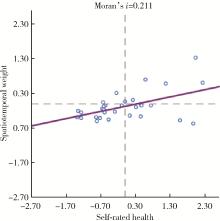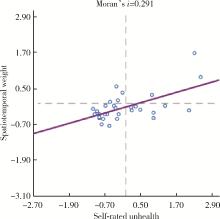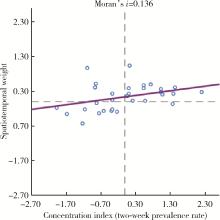北京大学学报(医学版) ›› 2024, Vol. 56 ›› Issue (2): 223-229. doi: 10.19723/j.issn.1671-167X.2024.02.004
中国流动人口自评健康状况影响因素及公平性
刘笑晗1,杨帆1,王昕迪2,黄宁1,程陶朱1,郭静1,*( )
)
- 1. 北京大学公共卫生学院卫生政策与管理学系,北京 100191
2. 华中科技大学社会学院社会学系,武汉 430074
Related factors and equity of health status among floating population in China based on geographic information system analysis
Xiaohan LIU1,Fan YANG1,Xindi WANG2,Ning HUANG1,Taozhu CHENG1,Jing GUO1,*( )
)
- 1. Department of Health Policy and Management, School of Public Health, Peking University Health Science Center, Beijing 100191, China
2. Department of Sociology, School of Sociology, Huazhong University of Science and Technology, Wuhan 430074, China
摘要:
目的: 了解中国流动人口健康状况及其空间分布和影响因素,评价健康公平性。方法: 使用2017年国家流动人口动态监测数据,采用二分类Logistic回归分析流动人口健康状况影响因素,采用集中指数法分析流动人口健康公平性,采用空间自相关法分析健康状况和健康公平性的空间聚集。结果: 中国流动人口不健康率为2.71%。年龄和性别对自评健康有显著影响,即随着年龄的增长,流动人口的自评健康逐渐变差,同时女性更容易认为自己不健康。公平性分析显示流动人口的集中指数为0.021 7,城市户籍流动人口为0.021 6,农村户籍流动人口为0.021 9,表明流动人口健康状况公平性偏向高收入阶层,农村户籍流动人口健康不公平程度大于城市户籍流动人口。自评健康全局Moran’ s i=0.211,不健康率全局Moran’ s i=0.291,表明自评健康有空间聚集趋势。流动人口两周患病率公平性Moran’ s i=0.136, 显示出空间聚集特征,且以北部和东南沿海地区为主。结论: 总体上中国流动人口健康状况较好,健康影响因素包括性别、年龄,健康不公平的集中趋势体现在东南沿海和北部地区,具有倾贫性特征。
中图分类号:
- R195
| 1 |
程梦瑶.中国流动人口的迁移转变与多元化发展[J].兰州学刊,2021,42(7):120-132.
doi: 10.3969/j.issn.1005-3492.2021.07.008 |
| 2 |
木永跃.流动人口社会风险治理: 理论与路径[J].上海行政学院学报,2021,22(2):91-101.
doi: 10.3969/j.issn.1009-3176.2021.02.010 |
| 3 | Wagstaff A .Poverty and health sector inequalities[J].Bull World Health Organ,2002,80(2):97-105. |
| 4 | 宋全成, 张倩.中国老年流动人口健康状况及影响因素研究[J].中国人口科学,2018,38(4):81-92. |
| 5 |
胡婉侠, 王丽, 王翠连, 等.流动老人自评健康状况及影响因素分析[J].中国农村卫生事业管理,2020,40(9):664-668.
doi: 10.3969/j.issn.1005-5916.2020.09.013 |
| 6 |
何南芙, 普亚姣, 李忠起, 等.中国流动老年人口健康状况影响因素及公平性[J].中国老年学杂志,2021,41(19):4398-4401.
doi: 10.3969/j.issn.1005-9202.2021.19.070 |
| 7 |
Connolly S , O'Reilly D , Rosato M .Increasing inequalities in health: Is it an artefact caused by the selective movement of people[J].Social Sci Med,2007,64(10):2008-2015.
doi: 10.1016/j.socscimed.2007.02.021 |
| 8 | 国家统计局. 中华人民共和国统计法[EB/OL]. [2023-09-30]. https://www.gov.cn/govweb/fwxx/bw/tjj/content_504312.htm. |
| 9 | 黄云, 任国强, 周云波.收入不平等对农村居民身心健康的影响: 基于CGSS2015数据的实证分析[J].农业技术经济,2019,38(3):25-37. |
| 10 | 刘瑞平, 李建新.我国中老年人健康不平等的变化趋势及相关因素分解[J].人口与发展,2022,28(5):43-55. |
| 11 |
梁维萍, 郑建中, 韩颖, 等.健康与卫生保健的公平性及其测量方法评介[J].中国农村卫生事业管理,2007,27(10):742-744.
doi: 10.3969/j.issn.1005-5916.2007.10.007 |
| 12 | 任国强, 胡梦雪.跨省流动人口健康自评状况及其影响因素分析: 基于2014年全国流动人口动态监测调查数据[J].中国卫生事业管理,2021,38(8):587-593, 625. |
| 13 | 薛利, 马天佩, 张文婕.城市新移民自评健康状况及其影响因素分析[J].中华疾病控制杂志,2018,22(11):1168-1172. |
| 14 | 潘竞虎, 张佳龙, 张勇.甘肃省区域经济空间差异的ESDA-GIS分析[J].西北师范大学学报(自然科学版),2006,42(6):83-87. |
| 15 | 薛莉萍, 范慧, 郭静.流动人口健康教育现状及其影响因素研究[J].中国健康教育,2017,33(9):771-774, 796. |
| 16 | Lu Y , Qin L .Healthy migrant and salmon bias hypotheses: A study of health and internal migration in China[J].Soc Sci Med,2014,102(4):41-48. |
| 17 | 李雨潼.中国老年流动人口特征及社会融入分析[J].社会科学战线,2021,44(3):270-275. |
| 18 | 张玲玲.上海金山区中学生2012与2017年日常饮食和缺乏体力活动行为比较[J].中国学校卫生,2019,40(6):913-916. |
| 19 | 段成荣, 谢东虹, 吕利丹.中国人口的迁移转变[J].人口研究,2019,43(2):12-20. |
| 20 | 李佳.基于差异性的流动人口社会融合研究[J].东南学术,2021,34(1):106-112. |
| 21 | 张检, 蔡金龙, 何中臣, 等.我国流动人口健康教育现状及其影响因素分析[J].中国健康教育,2021,37(4):291-296. |
| [1] | 沈鹤军,侍崇艳,郑清,黄玉,景涛. 我国高中生静坐时长与健康素养现状及其影响因素调查[J]. 北京大学学报(医学版), 2024, 56(2): 239-246. |
| [2] | 安思兰,郑群怡,王锴,高姗. 全膝关节置换术后患者早期疼痛的特点及其影响因素[J]. 北京大学学报(医学版), 2024, 56(1): 167-173. |
| [3] | 张艺潇,冯文. 决策树在贫困农村老人就诊影响因素中的应用[J]. 北京大学学报(医学版), 2018, 50(3): 450-456. |
| [4] | 景日泽,章湖洋,徐婷婷,张鲁豫,方海. 北京市三级公立医院效率及其影响因素[J]. 北京大学学报(医学版), 2018, 50(3): 408-415. |
| [5] | 赵雨薇,吴明. 北京市不同居住时间的农村流动人口门诊服务利用状况及其影响因素[J]. 北京大学学报(医学版), 2017, 49(3): 476-482. |
| [6] | 吴士艳,张旭熙,杨帅帅,孙凯歌,贾卫兰,邵春欣,吴芹,宣小伟,刘永昌,刘思佳,孙昕霙. 北京市某近郊区居民身体活动情况及其影响因素[J]. 北京大学学报(医学版), 2016, 48(3): 483-490. |
| [7] | 张磊, 吴明. 北京市外来农村流动人口自我医疗情况及其影响因素分析[J]. 北京大学学报(医学版), 2015, 47(3): 455-458. |
| [8] | 孙霄, 朱广荣, 季成叶, 王真真. 流出地校外青少年艾滋病相关危险行为及其影响因素[J]. 北京大学学报(医学版), 2012, 44(3): 369-374. |
| [9] | 卢新璞, 吴明. 北京市外来农村流动人口家庭医疗支出的影响因素——Tobit模型方法[J]. 北京大学学报(医学版), 2010, 42(5): 565-569. |
| [10] | 冯星淋, 沈娟, 郭岩. 儿童健康公平性的社会决定因素研究[J]. 北京大学学报(医学版), 2010, 42(3): 252-257. |
|






